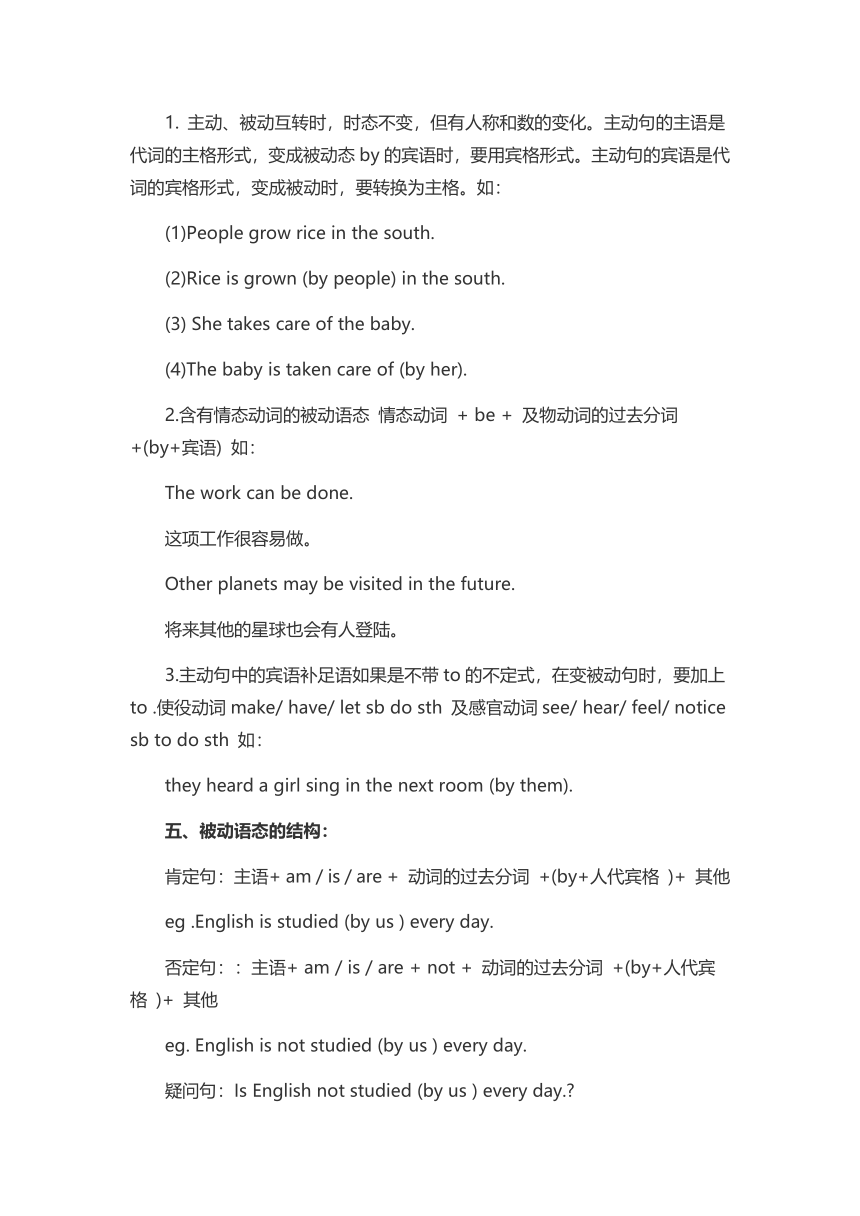一般现在时态被动和主动时态的结构讲义
图片预览


文档简介
一、英语语态有主动语态和被动语态两种。主语是动作的执行者,叫主动语态。
如: We clean the classroom. 我们打扫教室。
主语是动作的承受者,叫被动语态。
如:The classroom is cleaned (by us). 教室被(我们)打扫。
二、被动语态的构成:
助动词be +及物动词的过去分词+(by+宾语)其中by意为“被;由”,表动作的执行者。 如:The glass is broken by that boy.
玻璃杯是那个男孩打破的。
be有人称、数和时态的变化,其肯定式、否定式、疑问式的变化规则与be作为连系动词时完全一样。
如:English is widely spoken around the world. (肯定式)
English is not widely spoken around the world. (否定式)
Is English widely spoken around the world (疑问式)
Yes, it is./No, it isn’t.
三、被动语态的用法:
在没有指明动作的执行者或者不知道动作执行者的情况下可用被动语态。如:This coat is made of cotton.这件大衣是棉制的。 ·要强调动作的承受者而不是执行者时,用被动语态。 如:Her bike is stolen.她的自行车被偷了。
四、主、被动语态的转换:
主动语态:主语+及物动词谓语动词+宾语(+其它)
被动语态:主语+be+及物动词的过去分词+by+宾语(+其它)
注意:
1. 主动、被动互转时,时态不变,但有人称和数的变化。主动句的主语是代词的主格形式,变成被动态by的宾语时,要用宾格形式。主动句的宾语是代词的宾格形式,变成被动时,要转换为主格。如:
(1)People grow rice in the south.
(2)Rice is grown (by people) in the south.
(3) She takes care of the baby.
(4)The baby is taken care of (by her).
2.含有情态动词的被动语态 情态动词 + be + 及物动词的过去分词 +(by+宾语) 如:
The work can be done.
这项工作很容易做。
Other planets may be visited in the future.
将来其他的星球也会有人登陆。
3.主动句中的宾语补足语如果是不带to的不定式,在变被动句时,要加上to .使役动词make/ have/ let sb do sth 及感官动词see/ hear/ feel/ notice sb to do sth 如:
they heard a girl sing in the next room (by them).
五、被动语态的结构:
肯定句:主语+ am / is / are + 动词的过去分词 +(by+人代宾格 )+ 其他
eg .English is studied (by us ) every day.
否定句::主语+ am / is / are + not + 动词的过去分词 +(by+人代宾格 )+ 其他
eg. English is not studied (by us ) every day.
疑问句:Is English not studied (by us ) every day.
特殊疑问句:What/Where/When+ am / is / are +主语+动词的过去分词+ 其他
拓展:
这八种常用时态的主动和被动的'结构如下:
一、一般现在时
1.概念:指经常、反复发生的动作或行为及现在的某种状况。
2.时间状语:always, usually, often, sometimes, every week (day, year, month…), once a week, on Sundays.
二、一般过去时
1.概念:过去某个时间里发生的动作或状态;过去习惯性、经常性的动作、行为。
2.时间状语:ago, yesterday, the day before yesterday, last week(year, night, month…), in 1999, just now, at the age of 5, one day, long long ago, once upon a time, etc.
三、现在进行时
1.概念:表示现阶段或说话时正在进行的动作及行为。
2.时间状语:now, at this time, these days, etc.
四、过去进行时
1.概念:表示过去某段时间或某一时刻正在发生或进行的行为或动作。
2.时间状语:at this time yesterday, at that time或以when引导的谓语动词是一般过去时的时间状语等。
五、现在完成时
1.概念:过去发生或已经完成的动作对现在造成的影响或结果,或从过去已经开始,持续到现在的动作或状态。
2.时间状语:recently, lately, since…for…,in the past few years, etc.
六、过去完成时
1.概念:以过去某个时间为标准,在此以前发生的动作或行为,或在过去某动作之前完成的行为,即“过去的过去”。
2.时间状语:before, by the end of last year(term, month…),by the time...,etc.
七、一般将来时
1.概念:表示将要发生的动作或存在的状态及打算、计划或准备做某事。
2.时间状语:tomorrow, next day(week, month, year…),soon, in a few minutes, by…,the day after tomorrow, etc.
八、过去将来时
1.概念:立足于过去某一时刻,从过去看将来,常用于宾语从句中。
2.时间状语:the next day(morning, year…),the following month(week…),etc.
如: We clean the classroom. 我们打扫教室。
主语是动作的承受者,叫被动语态。
如:The classroom is cleaned (by us). 教室被(我们)打扫。
二、被动语态的构成:
助动词be +及物动词的过去分词+(by+宾语)其中by意为“被;由”,表动作的执行者。 如:The glass is broken by that boy.
玻璃杯是那个男孩打破的。
be有人称、数和时态的变化,其肯定式、否定式、疑问式的变化规则与be作为连系动词时完全一样。
如:English is widely spoken around the world. (肯定式)
English is not widely spoken around the world. (否定式)
Is English widely spoken around the world (疑问式)
Yes, it is./No, it isn’t.
三、被动语态的用法:
在没有指明动作的执行者或者不知道动作执行者的情况下可用被动语态。如:This coat is made of cotton.这件大衣是棉制的。 ·要强调动作的承受者而不是执行者时,用被动语态。 如:Her bike is stolen.她的自行车被偷了。
四、主、被动语态的转换:
主动语态:主语+及物动词谓语动词+宾语(+其它)
被动语态:主语+be+及物动词的过去分词+by+宾语(+其它)
注意:
1. 主动、被动互转时,时态不变,但有人称和数的变化。主动句的主语是代词的主格形式,变成被动态by的宾语时,要用宾格形式。主动句的宾语是代词的宾格形式,变成被动时,要转换为主格。如:
(1)People grow rice in the south.
(2)Rice is grown (by people) in the south.
(3) She takes care of the baby.
(4)The baby is taken care of (by her).
2.含有情态动词的被动语态 情态动词 + be + 及物动词的过去分词 +(by+宾语) 如:
The work can be done.
这项工作很容易做。
Other planets may be visited in the future.
将来其他的星球也会有人登陆。
3.主动句中的宾语补足语如果是不带to的不定式,在变被动句时,要加上to .使役动词make/ have/ let sb do sth 及感官动词see/ hear/ feel/ notice sb to do sth 如:
they heard a girl sing in the next room (by them).
五、被动语态的结构:
肯定句:主语+ am / is / are + 动词的过去分词 +(by+人代宾格 )+ 其他
eg .English is studied (by us ) every day.
否定句::主语+ am / is / are + not + 动词的过去分词 +(by+人代宾格 )+ 其他
eg. English is not studied (by us ) every day.
疑问句:Is English not studied (by us ) every day.
特殊疑问句:What/Where/When+ am / is / are +主语+动词的过去分词+ 其他
拓展:
这八种常用时态的主动和被动的'结构如下:
一、一般现在时
1.概念:指经常、反复发生的动作或行为及现在的某种状况。
2.时间状语:always, usually, often, sometimes, every week (day, year, month…), once a week, on Sundays.
二、一般过去时
1.概念:过去某个时间里发生的动作或状态;过去习惯性、经常性的动作、行为。
2.时间状语:ago, yesterday, the day before yesterday, last week(year, night, month…), in 1999, just now, at the age of 5, one day, long long ago, once upon a time, etc.
三、现在进行时
1.概念:表示现阶段或说话时正在进行的动作及行为。
2.时间状语:now, at this time, these days, etc.
四、过去进行时
1.概念:表示过去某段时间或某一时刻正在发生或进行的行为或动作。
2.时间状语:at this time yesterday, at that time或以when引导的谓语动词是一般过去时的时间状语等。
五、现在完成时
1.概念:过去发生或已经完成的动作对现在造成的影响或结果,或从过去已经开始,持续到现在的动作或状态。
2.时间状语:recently, lately, since…for…,in the past few years, etc.
六、过去完成时
1.概念:以过去某个时间为标准,在此以前发生的动作或行为,或在过去某动作之前完成的行为,即“过去的过去”。
2.时间状语:before, by the end of last year(term, month…),by the time...,etc.
七、一般将来时
1.概念:表示将要发生的动作或存在的状态及打算、计划或准备做某事。
2.时间状语:tomorrow, next day(week, month, year…),soon, in a few minutes, by…,the day after tomorrow, etc.
八、过去将来时
1.概念:立足于过去某一时刻,从过去看将来,常用于宾语从句中。
2.时间状语:the next day(morning, year…),the following month(week…),etc.
同课章节目录
- 词法
- 名词
- 动词和动词短语
- 动词语态
- 动词时态
- 助动词和情态动词
- 非谓语动词
- 冠词
- 代词
- 数词和量词
- 形容词副词及其比较等级
- 介词和介词短语
- 连词和感叹词
- 构词法
- 相似、相近词比较
- 句法
- 陈述句
- 一般疑问句和否定疑问句
- 特殊疑问句及选择疑问句
- 反意疑问句
- 存在句(There be句型)
- 宾语从句
- 定语从句
- 状语从句
- 主谓一致问题
- 简单句
- 并列句
- 复合句
- 主谓一致
- 主、表语从句
- 名词性从句
- 直接引语和间接引语
- 虚拟语气
- 感叹句
- 强调句
- 倒装句
- 祈使句
- 句子的成分
- 句子的分类
- 题型专区
- 单项选择部分
- 易错题
- 完形填空
- 阅读理解
- 词汇练习
- 听说训练
- 句型转换
- 补全对话
- 短文改错
- 翻译
- 书面表达
- 任务型阅读
- 语法填空
- 其他资料
